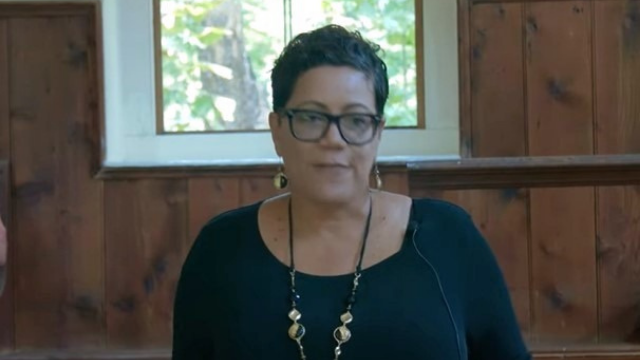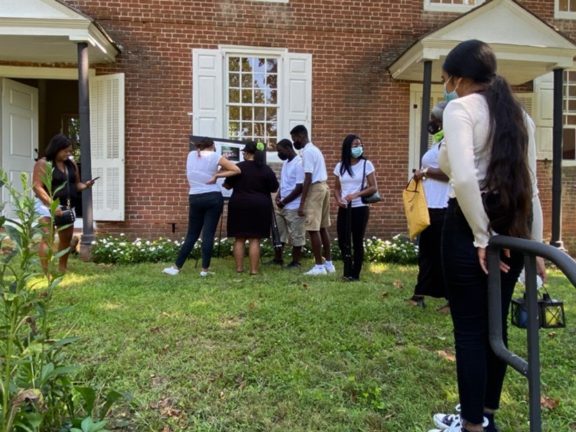
At the end of the winding road, known as Ye Greate Street, in Greenwich, Cumberland County, NJ, stands a historic Quaker meetinghouse. Built-in the mid-eighteenth century and known at that time as “The Place of Prophets,” the building – situated at present far from the bustle of contemporary life on the banks of the Cohansey River – remains an active, albeit seasonal, Friends meetinghouse today. Yet for all of its contemplative and rural qualities, Greenwich Friends Lower Meetinghouse also serves, at times, as a touchstone of community activism, storytelling, education, and outreach.

On a weekend this past September, for example, two events took place at Lower Meetinghouse.
Saturday, Sept. 11th was the 6th annual Prince Hall Community Festival in the nearby City of Bridgeton during which hundreds of visitors descended upon Bridgeton’s Cohansey waterfront to honor Boston’s prominent 18th-century abolitionist – founder of the world’s first lodge of Black Freemasonry, a service organization dedicated to improving the social, political, educational, and economic conditions of Black lives. Included in the festivities was a student-led bus tour of Underground Railroad sites in the Greenwich area. High school students from the Bridgeton Municipal Youth-to-Youth Alliance (supported by master educator Karen Barnett, and Cumberland County Commissioner, Donna Pearson) stopped at Lower Meetinghouse to examine the pivotal role Greenwich Friends played in aiding Freedom Seekers.
Then on Sunday, Sept 12th, as part of Salem Quarterly Meeting, Greenwich Friends presented a program featuring Cumberland County Prosecutor Jennifer Webb McCrae, outlining her efforts on a local level to achieve equal justice and safety for all.
We asked Lisa Stewart Garrison, the new Clerk of Greenwich Friends Meeting, to talk further with us about the weekend’s activities:
Q. Was the level of activity that weekend typical for Greenwich Friends Meeting?
As our member Kathy Barndt recently put it “After a period of quietism – activism.” The life of our meeting is a bit like a pendulum which sometimes appears to move between inward and outward momentum, but which is always incorporating both into our ongoing faith and practice. At times individuals take public stands with the meeting’s blessing, or we unite in supporting a member’s spiritual calling which may be activist in nature. Other times we are completely focused on deepening meeting for worship or trying to figure out how to best steward the aging sycamore trees on our meetinghouse grounds.
Q. Greenwich Friends Meeting is a relatively small group, yet Friends maintain an “Upper” and “Lower” Meetinghouse. Can you tell us a little bit about that?
As early as 1694, Greenwich Friends applied to Salem Quarter to build a log meeting house on the Cohansey River, and the current building, known today as Lower Meetinghouse, dates back to 1756.
Nearly a century later, three decades after the Orthodox/Hicksite split, Hicksite Friends constructed the building we now call Upper Meetinghouse.
Once the two branches of Quakerism united, Greenwich Friends joined together to steward both meetinghouses. Because Upper Meetinghouse is heated, we worship there from early October to late May, at which point we move to Lower Meetinghouse. It’s challenging to manage two sites, but each meetinghouse serves community purposes. In particular, Lower Meetinghouse is a contributing building in the Greenwich Historic District on the New Jersey and National Registers.
Q. What was involved with Greenwich hosting the September 12th Quarterly Meeting and how did you identify Jennifer Webb-McRae as a speaker?
We responded to the Steering Committee’s interest in a program that would touch upon racial, social, and criminal justice issues by developing one. Some of our members had worked previously with Cumberland County Prosecutor Jennifer Webb-McRae at a time when bail reform was first introduced in New Jersey, so we invited her as our speaker.
Jennifer drew from her own life story, detailed the preventive programs she has introduced in our county, and spoke candidly about the effects of racism in her own family as well as the criminal justice system. Interestingly, in recounting her experience growing up in an inter-racial family, she noted that her white maternal grandmother attended Friends’ Select School in Philadelphia.
She suggested her grandmother’s exposure to Quaker values as a student was among the factors that prepared her to accept and ultimately embrace her daughter’s eventual marriage to a Black man. Friends can access the content of Jennifer’s talk, recorded by Carlton Crispin.
Justice is a noun. But doing justice is a verb. As a prosecutor, I need to ensure that what we’re doing is fair, that people have confidence in our system, that it’s working well, and that it serves everyone. — Jennifer Webb-McRae
Q. Why did the high school students include Lower Meetinghouse as part of their interpretive tour of Underground Railroad sites that Saturday?
Some years ago, students from the Bridgeton Municipal Youth-to-Youth Alliance took part in a Freedom Tour of Underground Railroad sites (“Freedom Seekers, Free People of Color and Greenwich Quakers”) which I developed in response to a spiritual leading, with support from the Lyman Fund.

Among my goals in developing the Freedom Tours was to create inter-racial learning experiences, create multiple partnerships with government and civic groups and rekindle our meeting’s historic ties to local A.M.E. (African Methodist Episcopal) Churches. Our Lower Meetinghouse was an essential part of the tours from the start because local Quakers actively aided 19th century Freedom Seekers from Maryland and Delaware crossing Delaware Bay.
Since early Friends were careful not to keep written records of such activities, much of what we know about the role of Greenwich Friends comes from interviews and writings by Black spiritual leaders such Rev. Samuel Ringgold Ward and Rev. Thomas Clement Oliver.
Q. Your website is notable for the welcome message on the home page: “Whether or not you are a Quaker, if you are seeking a place to meditate with others, curious about the Society of Friends, researching historic buildings or Quakers, working on a school assignment, or interested in learning more, we welcome you to join us.” That feels very inclusive. Does the invitation generate interest among ‘Quaker tourists,’ neighbors, or schools?
We hope so.
Occasionally, Quakers from afar stop in or leave us messages. We aren’t always sure exactly how they know about us but it’s surely one of the ways we are visible.
Q. How did you assemble the right technology for a larger-than-normal hybrid program for the recent Quarterly Meeting? How did you handle the technology issues in the context of an historic meetinghouse?
We knew our technology was inadequate at Lower Meetinghouse and heard the frustration of our members on Zoom as they attempted to hear what was being said in the meetinghouse.
Because this was to be our first hybrid Quarterly Meeting, the pressure was on to improve the situation. We consulted with Nick Gutowski and Grace Cooke at PYM who sent links to what other meetings are doing to improve hybrid meetings. We also talked with a media-savvy neighbor of our meeting who advised us to use things we had on hand and avoid trying anything new, which might increase the possibility of glitches.
Prior to Quarterly Meeting, we had two people test the system, so we knew, in advance, that it would work. Specifically, so that people in the meetinghouse could hear people on zoom, we used a UE (Ultimate Ears) wireless speaker, plugged directly into my computer as we didn’t have time to adjust the blue tooth setting.
So that people on zoom could hear people in the meetinghouse, we used a Blue Yeti microphone with the mike set on “omnidirectional” so it would pick up sound from all directions. We still need to take steps so that people can see each other, but all agreed that our system worked!
In the 17th century, Lower Meetinghouse was situated on the Cohansey River to accommodate Friends living across the river. Our efforts at hybrid meetings aren’t perfect, but they’re a 21st-century expression of that age-old reach towards inclusiveness, which lies at the very foundation of how, where, and why our meetinghouse was built.
With thanks to Lisa Garrison (Greenwich Meeting) for her introduction to this Q&A
Photos courtesy of Lisa Garrison. The featured photograph is of Jennifer Webb-McRae and was taken during her presentation.